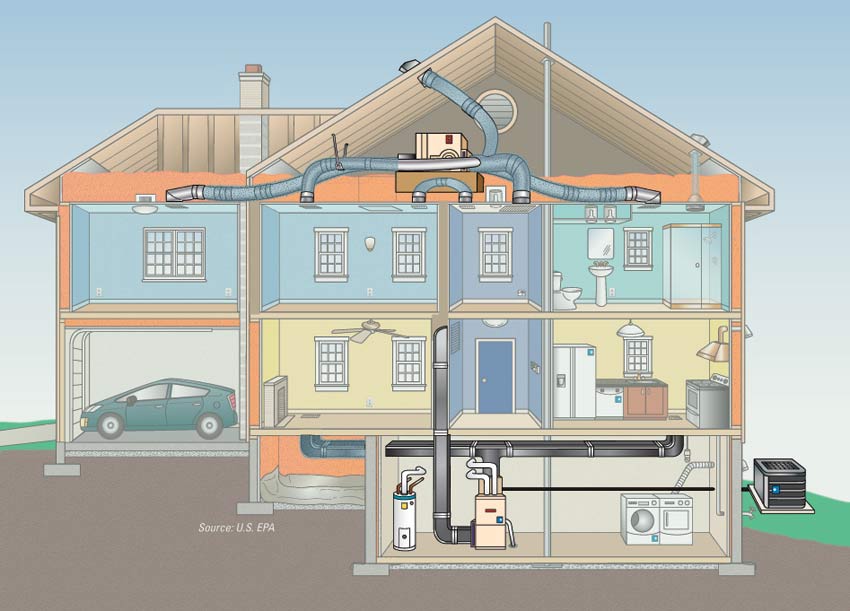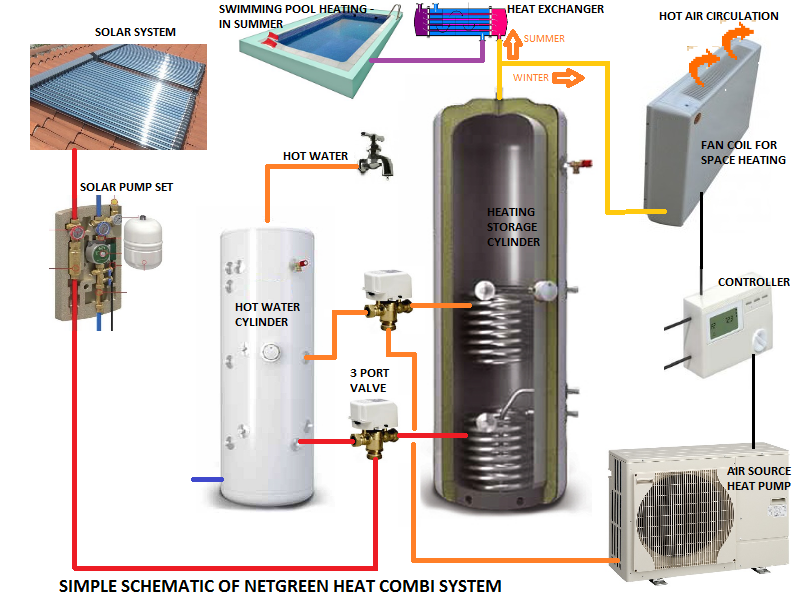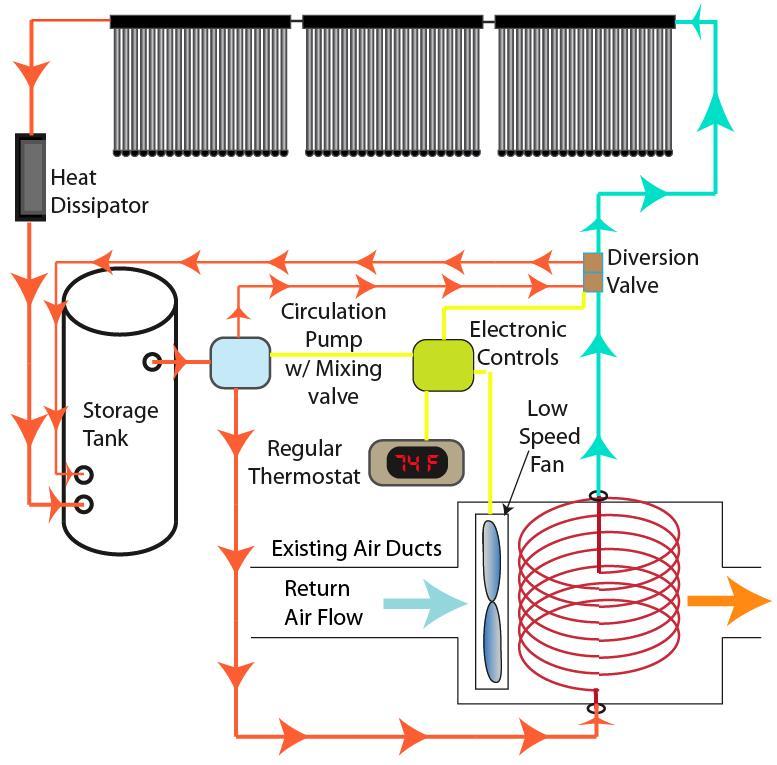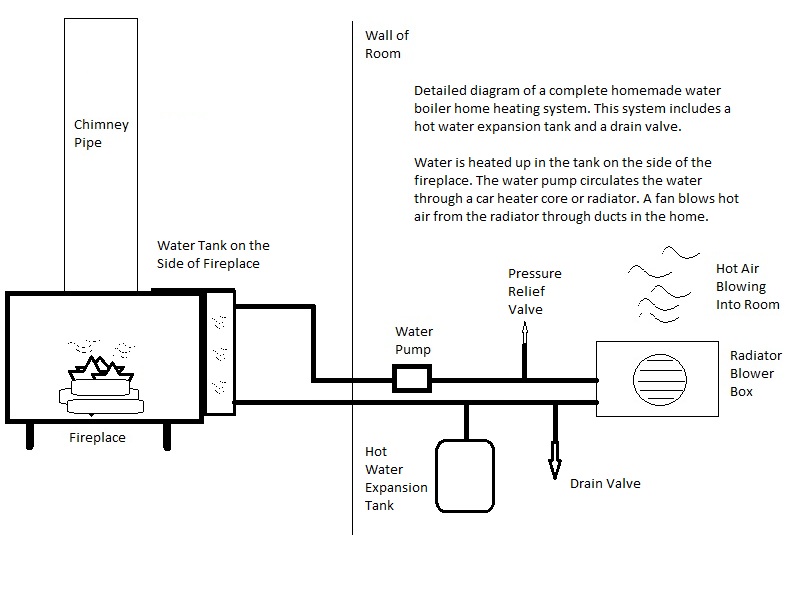A central heating system provides warmth to the whole interior of a building (or portion of a building) from one point to multiple rooms. When combined with other systems in order to control the building climate, the whole system may be an HVAC (heating, ventilation and air conditioning) system.

Overview
Central heating differs from space heating in that the heat generation occurs in one place, such as a furnace room in a house or a mechanical room in a large building (though not necessarily at the "central" geometric point). The heat is distributed throughout the building, typically by forced-air through ductwork, by water circulating through pipes, or by steam fed through pipes.
The most common method of heat generation involves the combustion of fossil fuel in a furnace or boiler. Increasingly, buildings utilize solar-powered heat sources, in which case the distribution system normally uses water circulation.
In much of the temperate climate zone, most new housing has come with central heating installed since the Second World War, at least. Such areas normally use gas heaters, district heating, or oil-fired system, often using forced-air systems. Steam-heating systems, fired by coal, oil or gas, are also used, primarily for larger buildings. Electrical heating systems occur less commonly and are practical only with low-cost electricity or when ground source heat pumps are used. Considering the combined system of central generating plant and electric resistance heating, the overall efficiency will be less than for direct use of fossil fuel for space heating.
House Heating System Video
History
Ancient Rome
The ancient Greeks originally developed central heating. The Temple of Ephesus was heated by Flues planted in the ground and circulating the heat which was generated by fire. Some buildings in the Roman Empire used central heating systems, conducting air heated by furnaces through empty spaces under the floors and out of pipes in the walls--a system known as a hypocaust.
The Roman hypocaust continued to be used on a smaller scale during late Antiquity and by the Umayyad caliphate, while later Muslim builder employed a simpler system of underfloor pipes.
After the collapse of the Roman Empire, overwhelmingly across Europe, heating reverted to more primitive fireplaces for almost a thousand years.
In the early medieval Alpine upland, a simpler central heating system where heat travelled through underfloor channels from the furnace room replaced the Roman hypocaust at some places. In Reichenau Abbey a network of interconnected underfloor channels heated the 300 m² large assembly room of the monks during the winter months. The degree of efficiency of the system has been calculated at 90%.
In the 13th century, the Cistercian monks revived central heating in Christian Europe using river diversions combined with indoor wood-fired furnaces. The well-preserved Royal Monastery of Our Lady of the Wheel (founded 1202) on the Ebro River in the Aragon region of Spain provides an excellent example of such an application.
Modern central heating systems
The three main methods of central heating were developed in the late 18th to mid-19th centuries.
Hot air
William Strutt designed a new mill building in Derby with a central hot air furnace in 1793, although the idea had been already proposed by John Evelyn almost a hundred years earlier. Strutt's design consisted of a large stove that heated air brought from the outside by a large underground passage. The air was ventilated through the building by large central ducts.
In 1807, he collaborated with another eminent engineer, Charles Sylvester, on the construction of a new building to house Derby's Royal Infirmary. Sylvester was instrumental in applying Strutt's novel heating system for the new hospital. He published his ideas in The Philosophy of Domestic Economy; as exemplified in the mode of Warming, Ventilating, Washing, Drying, & Cooking, ... in the Derbyshire General Infirmary in 1819. Sylvester documented the new ways of heating hospitals that were included in the design, and the healthier features such as self-cleaning and air-refreshing toilets. The infirmary's novel heating system allowed the patients to breathe fresh heated air whilst old air was channeled up to a glass and iron dome at the centre.
Their designs proved very influential. They were widely copied in the new mills of the Midlands and were constantly improved, reaching maturity with the work of de Chabannes on the ventilation of the House of Commons in the 1810s. This system remained the standard for heating small buildings for the rest of the century.
Steam
The English writer Hugh Plat proposed a steam based central heating system for a greenhouse in 1594, although this was an isolated occurrence and was not followed up until the 18th century. Colonel Coke devised a system of pipes that would carry steam around the house from a central boiler, but it was James Watt the Scottish inventor who was the first to build a working system in his house.
A central boiler supplied high-pressure steam that then distributed the heat within the building through a system of pipes embedded in the columns. He implemented the system on a much larger scale at a textile factory in Manchester. Robertson Buchanan wrote the definitive description of these installations in his treatises published in 1807 and 1815. Thomas Tredgold's work Principles of Warming and Ventilating Public Buildings, delineated the method of the application of hot steam heating to smaller, non-industrial buildings. This method had superseded the hot air systems by the late 19th century.
Hot water
Early hot water systems were used in Russia for central heating of the Summer Palace (1710-1714) of Peter the Great in Saint Petersburg. Slightly later, in 1716, came the first use of water in Sweden to distribute heating in buildings. Mårten Triewald, a Swedish engineer, used this method for a greenhouse at Newcastle upon Tyne. Jean Simon Bonnemain (1743-1830), a French architect, introduced the technique to industry on a cooperative, at Château du Pêcq, near Paris.
However, these scattered attempts were isolated and mainly confined in their application to greenhouses. Tredgold originally dismissed its use as impractical, but changed his mind in 1836, when the technology went into a phase of rapid development.
Early systems had used low pressure water systems, which required very large pipes. One of the first modern hot water central heating systems to remedy this deficiency were installed by Angier March Perkins in London in the 1830s. At that time central heating was coming into fashion in Britain, with steam or hot air systems generally being used.
Perkins' 1832 apparatus distributed water at 200 degrees Celsius through small diameter pipes at high pressure. A crucial invention to make the system viable was the thread screwed joint, that allowed the joint between the pipes to bear a similar pressure to the pipe itself. He also separated the boiler from the heat source to reduce the risk of explosion. The first unit was installed in the home of Governor of the Bank of England John Horsley Palmer so that he could grow grapes in England's cold climate.
His systems were installed in factories and churches across the country, many of them remaining in usable condition for over 150 years. His system was also adapted for use by bakers in the heating of their ovens and in the making of paper form wood pulp.
Franz San Galli, a Polish-born Russian businessman living in St. Petersburg, invented the radiator between 1855 and 1857, which was a major step in the final shaping of modern central heating. The Victorian cast iron radiator became widespread by the end of the 19th century.

Energy sources
The energy source selected for a central heating system varies by region. The primary energy source is selected on the basis of cost, convenience, efficiency and reliability. The energy cost of heating is one of the main costs of operating a building in a cold climate. Some central heating plants can switch fuels for reasons of economy and convenience; for example, a home owner may install a wood-fired furnace with electrical backup for occasional unattended operation.
Solid fuels such as wood, peat or coal can be stockpiled at the point of use, but are inconvenient to handle and difficult to automatically control. Wood fuel is still used where the supply is plentiful and the occupants of the building don't mind the work involved in hauling in fuel, removing ashes, and tending the fire. Pellet fuel systems can automatically stoke the fire, but still need manual removal of ash. Coal was once an important residential heating fuel but today is rarely found.
Liquid fuels are petroleum product such as heating oil and kerosene. These are still widely applied where other heat sources are unavailable. Fuel oil can be automatically fired in a central heating system and requires no ash removal and little maintenance of the combustion system. However, the variable price of oil on world markets leads to erratic and high prices compared to some other energy sources. Institutional heating systems (office buildings or schools, for example) can use low-grade, inexpensive bunker fuel to run their heating plants, but capital cost is high compared to more easily managed liquid fuels.
Natural gas is a widespread heating fuel in North America and northern Europe. Gas burners are automatically controlled and require no ash removal and little maintenance. However, not all areas have access to a natural gas distribution system. Liquified petroleum gas or propane can be stored at the point of use and periodically replenished by a truck-mounted mobile tank.
Some areas have low cost electric power, making electric heating economically practical. Electric heating can either be purely resistance-type heating or make use of a heat pump system to take advantage of low-grade heat in the air or ground.
A district heating system uses centrally located boilers or water heaters and circulates heat energy to individual customers by circulating hot water or steam. This has the advantage of a central highly efficient energy converter than can use the best available pollution controls, and that is professionally operated. The district heating system can use heat sources impractical to deploy to individual homes, such as heavy oil, wood byproducts, or (hypothetically) nuclear fission. The distribution network is more costly to build than for gas or electric heating, and so is only found in densely populated areas or compact communities.
Not all central heating systems require purchased energy. A few buildings are served by local geothermal heat, using hot water or steam from a local well to provide building heat. Such areas are uncommon. A passive solar system requires no purchased fuel but needs to be carefully designed for the site.

Water heating
Circulating hot water can be used for central heating. Sometimes these systems are called hydronic heating systems
Common components of a central heating system using water-circulation include:
- A supply of fuel, electric power or district heating supply lines
- A Boiler (or a heat exchanger for district heating) which heats water in the system
- Pump to circulate the water
- Radiators which are wall-mounted panels through which the heated water passes in order to release heat into rooms.
The circulating water systems use a closed loop; the same water is heated and then reheated. A sealed system provides a form of central heating in which the water used for heating circulates independently of the building's normal water supply.
An expansion tank contains compressed gas, separated from the sealed-system water by a diaphragm. This allows for normal variations of pressure in the system. A safety valve allows water to escape from the system when pressure becomes too high, and a valve can open to replenish water from the normal water supply if the pressure drops too low. Sealed systems offer an alternative to open-vent systems, in which steam can escape from the system, and gets replaced from the building's water supply via a feed and central storage system.
Heating systems in the United Kingdom and in other parts of Europe commonly combine the needs of space heating with domestic hot-water heating. These systems occur less commonly in the USA. In this case, the heated water in a sealed system flows through a heat exchanger in a hot-water tank or hot-water cylinder where it heats water from the regular potable water supply for use at hot-water taps or appliances such as washing machines or dishwasher
Hydronic radiant floor heating systems use a boiler or district heating to heat water and a pump to circulate the hot water in plastic pipes installed in a concrete slab. The pipes, embedded in the floor, carry heated water that conducts warmth to the surface of the floor, where it broadcasts heat energy to the room above. Hydronic heating systems are also used with antifreeze solutions in ice and snow melt systems for walkways, parking lots and streets. They are more commonly used in commercial and whole house radiant floor heat projects, whereas electric radiant heat systems are more commonly used in smaller "spot warming" applications.

Steam heating
A steam heating system takes advantage of the high latent heat which is given off when steam condenses to liquid water. In a steam heating system, each room is equipped with a so-called "radiator" which is connected to a source of low-pressure steam (a boiler). Steam entering the radiator condenses and gives up its latent heat, returning to liquid water. The radiator in turn heats the air of the room, and provides some direct radiant heat. The condensate water returns to the boiler either by gravity or with the assistance of a pump. Some systems use only a single pipe for combined steam and condensate return. Since trapped air prevents proper circulation, such systems have vent valves to allow air to be purged. In domestic and small commercial buildings, the steam is generated at relatively low pressure, less than 15 psig (200 kPa).
Steam heating systems are rarely installed in new single-family residential construction owing to the cost of the piping installation. Pipes must be carefully sloped to prevent trapped condensate blockage. Compared to other methods of heating, it is more difficult to control the output of a steam system. However, steam can be sent, for example, between buildings on a campus to allow use an efficient central boiler and low cost fuel. Tall buildings take advantage of the low density of steam to avoid the excessive pressure required to circulate hot water from a basement mounted boiler. In industrial systems, process steam used for power generation or other purposes can also be tapped for space heating. Steam for heating systems may also be obtained from heat recovery boilers using otherwise wasted heat from industrial processes.

Electric heaters
Electric heating or resistance heating converts electricity directly to heat. Electric heat is often more expensive than heat produced by combustion appliances like natural gas, propane, and oil. Electric resistance heat can be provided by baseboard heaters, space heaters, radiant heaters, furnaces, wall heaters, or thermal storage systems.
Electric heaters are usually part of a fan oil which is part of a central air conditioner. They circulate heat by blowing air across the heating element which is supplied to the furnace through return air ducts. Blowers in electric furnaces move air over one to five resistance coils or elements which are usually rated at five kilowatts. The heating elements activate one at a time to avoid overloading the electrical system. Overheating is prevented by a safety switch called a limit controller or limit switch. This limit controller may shut the furnace off if the blower fails or if something is blocking the air flow. The heated air is then sent back through the home through supply ducts.
In larger commercial applications, central heating is provided through an air handler which incorporates similar components as a furnace but on a larger scale.

Heat pumps
In mild climates a air source heat pump can be used to air condition the building during hot weather, and to warm the building using heat extracted from outdoor air in cold weather. Air-source heat pumps are generally uneconomic for outdoor temperatures much below freezing. In colder climates, geothermal heat pumps can be used to extract heat from the ground. For economy, these systems are designed for average low winter temperatures and use supplemental heating for extreme low temperature conditions. The advantage of the heat pump is that it reduces the purchased energy required for building heating; often geothermal source systems also supply domestic hot water. Even in places where fossil fuels provide most electricity, a geothermal system may offset greenhouse gas production since most of the heat is supplied from the surrounding environment, with only 15-30% as electrical consumption.

Environmental aspects
From an energy-efficiency standpoint considerable heat gets lost or goes to waste if only a single room needs heating, since central heating has distribution losses and (in the case of forced-air systems particularly) may heat some unoccupied rooms without need. In such buildings which require isolated heating, one may wish to consider non-central systems such as individual room heaters, fireplaces or other devices. Alternatively, architects can design new buildings which can virtually eliminate the need for heating, such as those built to the Passive House standard.
However, if a building does need full heating, combustion central heating offers a more environmentally friendly solution than electric-air central heating or than other direct electric heating devices. This stems from the fact that most electricity originates remotely using fossil fuels, with up to two-thirds of the energy in the fuel lost (unless utilized for district heating) at the power station and in transmission losses. In Sweden proposals exist to phase out direct electric heating for this reason (see oil phase-out in Sweden). Nuclear and hydroelectric sources reduce this factor.
In contrast, hot-water central heating systems can use water heated in or close to the building using high-efficiency condensing boilers, biofuels, or district heating. Wet underfloor heating has proven ideal. This offers the option of relatively easy conversion in the future to use developing technologies such as heat pumps and solar combisystems, thereby also providing future-proofing.
Typical efficiencies for central heating (measured at the customer's purchase of energy) are: 65-97% for gas fired heating; 80-89% for oil-fired, and 45-60% for coal-fired heating.
Are You Looking for Products
Here some products related to "Central Heating".
Amazon.com - Dr Infrared ..
Eccotemp L5 Portable Tank..
Kohler GM79141-KP1 Fuel R..
Amazon.com - Whynter 14, ..
Get these at Amazon.com* amzn.to is official short URL for Amazon.com, provided by Bitly
Source of the article : here






8 komentar
This was a really great read, I didn't know that the idea of central heating dated as far back as Rome. My wife and I recently had to have the central heating in our house redone; it is an older house and really didn't have a system that could keep us comfortable. We decided to try some more energy efficient heaters in order to save money, but I am just glad to have the house heated again. http://www.mountainmechanicalak.com
Great information about your home and heating. I love the lay out by the way. It's so hard to keep the heat regulated the way I want. I will have to try some of the tricks you have shown as it appears to be a user friendly way of keeping things warm by opening the correct windows in the house.
Roxanne Vaughn @ Total Plumbing Inc.
I just got a new combi boiler unit installed in my flat, and I love it! It saves a lot of space, and the fact that it can provide a steady stream of hot water is a huge benefit, especially in the mornings when both my girlfriend and I have to take a shower. I couldn’t recommend it more.
Wilfred Andrews @ LB Plumbing and Heating
My husband and I have been complaining to each other about our central heating. It's been on the fritz which is terrible since it's winter. This blog post has been really helpful in telling us about our options. I definitely didn't know there were different kinds of central heating. I've never heard of water, steam, or electric central heating. With this information my husband and I will definitely know how we want to fix or upgrade our central heating.
Lane Pemberton @ Metcalfe Heating & Air Conditioning
I agree with you, Central Heating is the even distribution of heat to every room in your home from a central point or heat source.
Central Heating Company
You must choose an appropriate central heating system. Buying it requires an understanding of the different types of it.
It is my great pleasure to visit your website and get useful information. I like that very much.
central heating
Thanks for sharing the information regarding central heating system which keep our home warmth to the whole interior of a building from one point to multiple rooms.
System integration
EmoticonEmoticon